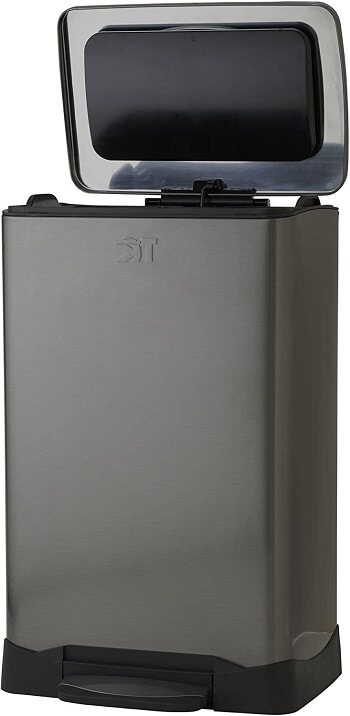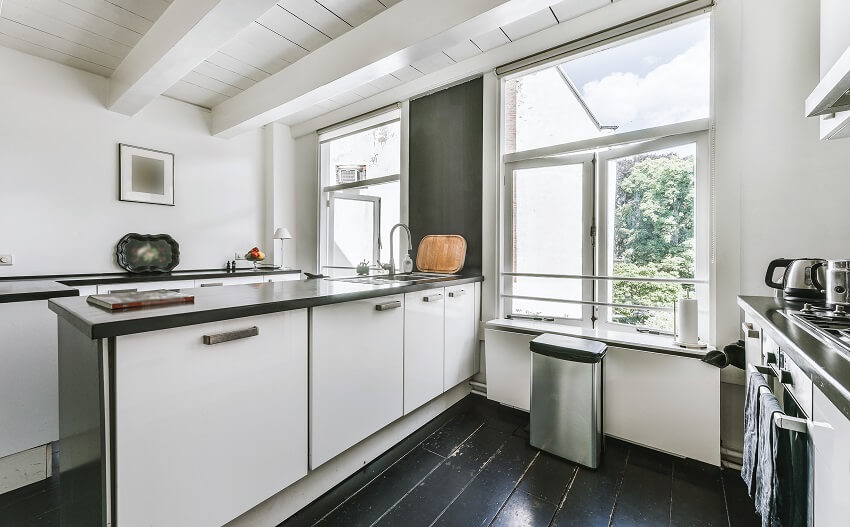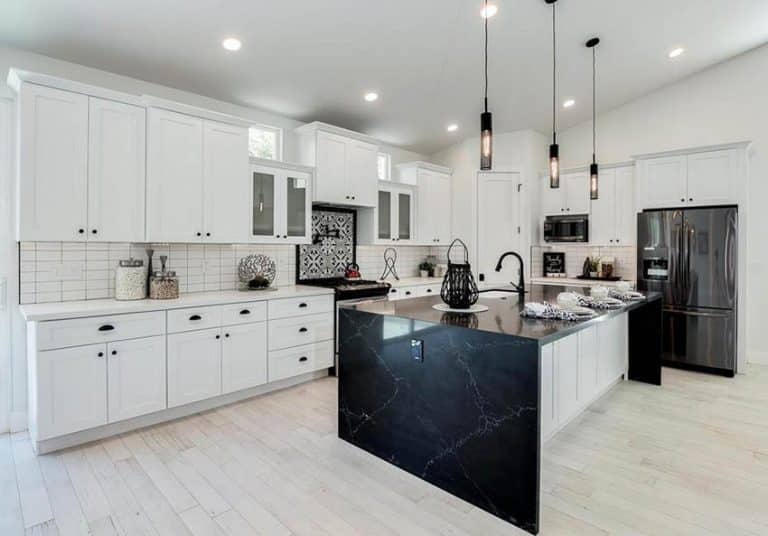Trash Compactor Pros and Cons
Here we share our trash compactor pros and cons guide including its different types, sizes, costs, tips on how to maintain a trash compactor, and if it’s worth it.

Installing a trash compactor, which is primarily a utility appliance, entails minimal trips to the curbside or trash can with sacks of waste. A trash compactor takes up significantly less room than the trash that has been bagged.
Nevertheless, the compactor necessitates the use of specialized bags, which might need the purchase of the appropriate type while shopping.
Is it necessary to have a trash compactor in your house, particularly in your kitchen? The answer is contingent on your requirements, although there are clear benefits to obtaining one. There are, unfortunately, certain drawbacks.
Let us now begin discussing the pros and cons of a trash compactor to help you determine if this appliance is ideal for your household.
What Is A Garbage Compactor?
A trash compactor, which is typically placed in your kitchen, is comparable to a standard trash can but has several distinctions. This trash can boasts a hydraulic-powered metal ram that smashes rubbish into a denser and compressed volume.
This package may then be packed and discarded in your backyard garbage can or at any nearby waste disposal site.
How Does A Compactor for Trash Work?
Trash compactors are quite convenient to use and have only three elements: a metal-based ram that presses the waste, a container to hold the waste, and an electronic switch that activates the unit. A trash compactor is indeed user-friendly and very easy to operate.
All you have to do is put your trash in the container, and when it starts to overflow, close the container and switch on the compactor.
The majority of advanced trash compactor models now include supplementary safety functionalities including an alarm that will activate if a malfunction occurs or if the bin is incorrectly packed.
However, a trash compactor is indeed an incredibly powerful and effective appliance, and you and your household members must take definite precautionary measures when using it.
Do not use your feet or hands to thrust the waste into the bin. Furthermore, do not ever let your children play near an unsupervised trash compactor or operate it without your guidance.
Advantages of a Trash Compacting Appliance
Trash compactors are truly reliable in terms of keeping your house, especially your kitchen, clean and hygienic. Here are some of its pros that will truly amaze you:
• Convenience: Indeed, compacted waste tends to take up substantially less space than non-compacted waste, implying that the garbage will not need to be emptied as frequently. This also implies that you will need a very minimal amount of traditional garbage bags and might be able to use fewer curbside garbage cans.
• Keep Trash Cans Out of Sight: Trash compactors can be permanently installed in your kitchen to keep trash out of sight. Similar to a dishwasher or a stovetop, trash compactors are engineered to fit underneath the countertop in a kitchen. This is ideal for individuals who have a small kitchen design or live in an apartment complex.
• Environmentally Friendly: Trash that has been compacted consumes less space in governmental dumpsites and landfills, lowering your household’s environmental impact.
• Can Promote Better Recycling: Trash compactors can aid in the advancement of recycling. Several homeowners use their trash compactor to produce recyclable items like aluminum cans, plastic containers, storage boxes, and so on.
• Can Save On Waste Expense: Getting your trash compacted can lead to significant savings on trash collection costs including city or homeowner association charges if your household generates so much waste that you necessitate additional exterior garbage bins.
Drawbacks of Compacting Garbage in the Kitchen
Despite its many benefits, a trash compactor can also have its drawbacks.
• Can Break Down: You will have to repair your trash compactor at some point because just like any other appliance, it tends to become damaged, particularly when overused. Fixing a trash compactor is unlikely to occur with a new unit, but it might become possible as the appliance gets old.
• Can Create Odors: Since your garbage remains inside your trash compactor for a prolonged period, undesirable odors may develop. However, once you start noticing undesirable smells, you can eliminate them with some air disinfectant or by discarding the waste.
• Trash May Be Difficult to Lift Out: Keep in mind that compacted trash is much heavier. Some individuals, such as kids who have been assigned to undertake garbage chores, may find it difficult to lift as a result of this.
• May Need to Be Serviced At a Cost: A trash compactor, just like any other appliance, can sometimes malfunction. Strange noises, inadequate compaction, or a jammed compactor door are all indications that your trash compactor needs to be serviced.
• Needs Special Trash Bags: Regular garbage bags are not suitable to be used in a trash compactor as they are not intended to withstand the intense pressure applied to compress trash inside the compactor. Specialized trash compactor bags are required, which must be purchased in a particular size crafted for your compactor model.
Types Of Compactor Kitchen Appliances
It is important to consider first which type of trash compactor will work optimally in your kitchen before making a purchase. Here are the different types of trash compactors you can choose from:
Under-Counter (Built-In) Compactor

Under-counter trash compactors, also recognized as built-in trash compactors, are mounted between two low kitchen cabinets, just like a dishwasher. They are generally obtainable in standard cabinet widths, allowing them to be used to replace a cabinet. Read more about kitchen cabinet dimensions here.
Moreover, they have unfinished tops and, contingent on your skill level could necessitate professional configuration. Some compactors are engineered to enable you to add your front panel so that the compactor blends in with the remaining portion of your kitchen cabinet.
Portable (Convertible) Compactor
Convertible trash compactors, also known as portable compactors, can be used in a freestanding setup. However, it can be installed under your kitchen counter as well.
They have finished surfaces but can be transformed into a built-in appliance in the event of a kitchen renovation. Check out our guide to kitchen counter measurements to get more ideas.
Freestanding Waste Compactor

Freestanding trash compactors are very ideal for those homeowners who have finished kitchens since they do not require any modification. The only restriction is that if they are operated via electricity, they must be situated near a plug socket.
Furthermore, freestanding trash compactors have finished surfaces made out of the same content as the remainder of the trash can. Since they are not designed to be installed underneath a counter, the top can be used as an additional working surface.
Compactor Trash Can
Compactor trash cans use ramming pressure to decrease trash quantity. If you put one in the kitchen, no doubt you will make very few visits to the outside garbage can. Generally, models are available in black, white, and stainless steel.
If your conventional trash can is often jam-packed, a compactor trash can would be an ideal contribution to your household. Whenever it is full, simply lift the handle and press it down to compress the garbage. It can hold three times the amount of trash as a standard bin, so you will be taking out less trash.
Sink Disposal Compactor

A sink trash compactor, also identified as a garbage disposal, is configured to obtain solid food waste in a crushing chamber and is installed to the undersurface of a sink. When you switch on the disposal, a rotating disc, also known as an impeller plate, spins quickly, pushing the garbage against the exterior wall of the crushing chamber.
Most food waste is organic and so is biodegradable. Much food waste can be composted and need not be put into a landfill. – Kitchen Planning Guidelines: Codes, Standards By NKBA (National Kitchen and Bath Association), 2013
The food or any waste that is put into the sink trash compactor is pulverized into small fragments, which are then washed by water through openings in the chamber surface.
While disposals do indeed have multiple rough metallic teeth known as impellers, on the impeller plate, they do not have sharp razors, as is generally assumed.
Installing a sink trash compactor is relatively simple, but it does necessitate some quite fundamental plumbing and electrical circuitry skill set. The majority of handy homeowners can install a new sink trash compactor in a matter of hours.
Electric Refuse Compactor
Electricity is used to compact trash with a metal-made ram in automatic or electric options. Automatic trash compactors must be plugged into a power socket. Moreover, they have strong motors that provide a lot of compression coercion to compress your waste.
Automatic trash compactors are indeed more efficient and necessitate less physical effort from you. Unfortunately, they are considerably more costly.
Control systems on automatic (electric-powered) trash compactors enable you to control the appliance. Although the majority of trash compactors operate straightforwardly, some models have additional features such as a bag retainer switch to guarantee that the trash container does not become separated.
Hidden control panels have a more streamlined appearance, and touch-control panels without raised buttons are easier to maintain.
Numerous automatic models have sensors that recognize whenever the drawer is open and, as an extra safety function, stop the appliance from operating. Some models also include a sensor that notifies you when the trash can is overflowing.
Manual Operation Compactor

Manual models are typically equipped with a crushing system that must be operated by hand. Manual trash compactors do not use motors and instead rely on your physical effort to give compression power.
They are less impactful than automatic models and should not be used to condensate glass or cans. Manual models, on the other hand, are significantly less expensive than automatic models.
Compactor Dimensions
The majority of trash compactors on the market are designed to fit inside conventional kitchen cabinets. They are typically 12 to 15 inches in width, 34 to 35 inches in height, and 24 inches in depth. If you choose a built-in variant, you must measure it to ascertain that it will perfectly fit.
The capacity of a trash compactor is determined by its type. Automatic variants generally have capacities ranging from 1.4 to 1.7 cubic feet.
On the other hand, manual variants are typically measured in gallons and can collect between 5 to 10 gallons of waste. For your reference, the typical capacity of 1.4 cubic feet for automatic variants is roughly 10.5 gallons. See our guide to standard trash compactor sizes here.
How Much Does A Compactor Cost?
The average cost of a trash compactor is around $1,400 to $1,700 and generally ranges from $700 to $2,500, depending on the manufacturer. If you wish to hire a professional to install your new trash compactor, you can expect to pay between $150 and $250 for labor alone.
Having an expert contractor configure your new trash compactor eliminates the need for you to perform the exhausting legwork. The contractor will prepare the site, hook up your compactor, and clean up the task area. They have all of the necessary equipment and machinery to accomplish the task properly.
To reduce waste in the kitchen, a trash compactor would be an appealing investment. Numerous manufacturers sell trash compactors at various prices, but the final choice is determined by your budget and requirements.
Here is the summary of the costs. This would be very helpful when planning to buy and install a trash compactor:
• Cost of a trash compactor: $700 to $2,500
• Freestanding trash compactor cost: $700 to $900
• Under-counter (Built-in) trash compactor cost: $900 to $2,400
• Convertible (Portable) trash compactor cost: $1,000 to $1,300
• Sink trash compactor cost: $700 to $800
• Installation: $150 to $250
• Tools, supplies, and pieces of machinery if necessary: $15 to $30
• Total project cost range: $900 to $2,700
How Long Do Compactors Last?
Trash compactors for non-professional use at home frequently last 7 to 12 years. The lifespan of 7 years is mainly for trash compactor models that were misused or did not receive routine maintenance. However, trash compactors that have lasted 11 years have received proper maintenance.
The lifespan of 11 to 12 years is recognized as the industry average for a properly maintained trash compactor that did not undertake inordinate utilization, probably just the usual quantities of garbage.
The 8 to the 10-year range is a result of a combination of influences, including second-hand appliances, compactors that were only slightly maintained, and compactors that were mishandled; all of such dilemmas might reduce the longevity of a trash compactor.
How To Maintain Compactors Efficiently
There are a few easy ways to keep your trash compactor in good condition for the next 11 years or more. To begin, review your trash compactor’s instruction booklet for maintenance guidelines.
Aside from that, make sure to check the recommended regularity of those tasks as well. A cautionary note: always deactivate the trash compactor before cleaning, maintaining, or repairing it. Ensure to wear gloves to safeguard your hands from shattered glass and particles.
In general, each brand and model of trash compactor necessitates the lubrication of the hinges and other mechanical components. Incorporate this task into your calendar to avert overlooking an important aspect of the appliance’s routine maintenance.
The air filter is critical for prohibiting mold growth within the compactor. It should be inspected and replaced regularly. Assume that the activities will be outside of your skillset or level of experience.
If you have any questions or would like to be referred to a repair person in your neighborhood, contact the manufacturer’s customer support.
These are the other important tips and reminders for you to maintain your trash compactor properly:
• As much as possible, avoid leaving spills within your compactor. The liquid will make a mess and may emit unpleasant odors from the trash compactor.
To avoid this problem, place cans flat on the lowest part of the container so that the compactor can squeeze them without allowing any residual fluids to splatter within the compactor.
• Trash compactors become dirty as a result of trash handling and must be cleaned manually to prevent the development of potentially hazardous bacteria. To minimize the risks, use antimicrobial cleaners.
Brush the inner and outer surface to get rid of all grime and detritus. Afterward, before replacing the specialized trash bag, thoroughly clean the compactor.
• Numerous trash compactor models include air fresheners or odor-absorbing filtration systems. If your model possesses these features, it is essential to keep replacing the filters regularly to avoid unpleasant odors.
You can also add a layer of baking soda to the lowest part of the compactor, particularly under the trash bag, every time you replace it.
Are Compactors For Trash Worth It?
Generally speaking, yes, trash compactors are worth it. Trash compactors offer numerous advantages to hectic-scheduled families. Operating a trash compactor on a very regular basis in your home can decrease waste quantity by 75% annually. This is a truly astonishing figure.
This appliance will not only decrease the amount of space your trash takes up in the dumpsite, but it will also decrease the frequency with which you unload the trash can and minimize the number of trips to the landfill.
Furthermore, these innovative systems do not eliminate the need to recycle glasses, cardboard, papers, plastics, and other recyclable items. Rather, the trash compactor will decrease the volume of non-recyclable waste and the large quantity of the waste before it is disposed of in a dumpsite.
Another useful option provided by trash compactors is the ability to obliterate soda cans, storage boxes, and reusable plastics to arrange the components for the recycling facility. Lowering trash volumes and properly arranging recyclables will significantly decrease the environmental impact of your house or apartment.
Moreover, another advantage of having a trash compactor is that the overall amount of your trash will be substantially reduced, which may help you save money on trash disposal and homeowner association expenses for exterior garbage bins.
Visit our garbage disposal pros and cons for more related content.













